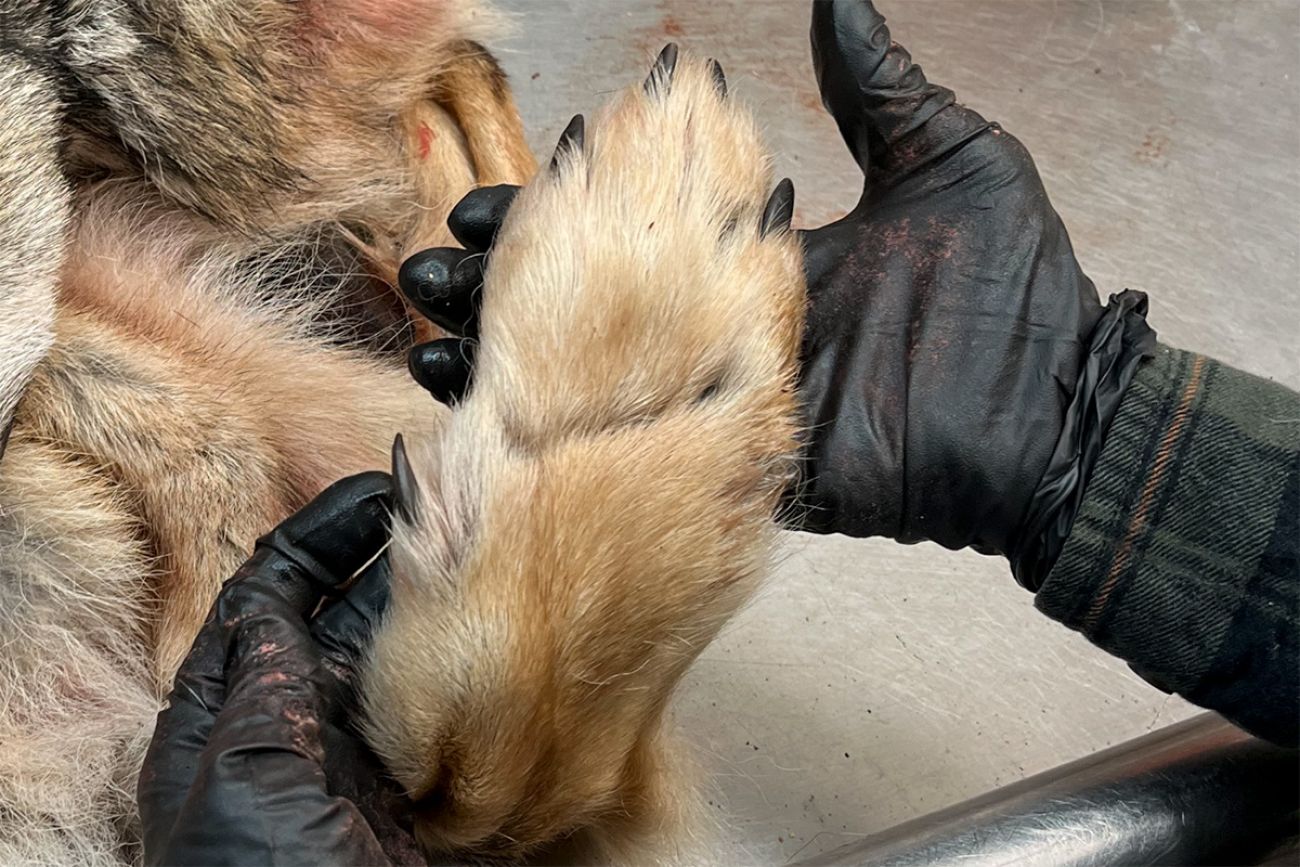Southern Michigan dead wolf mystery deepens; records suggest it was trapped


- Investigative reports appear to support a hunter’s version that he killed a wolf in January in southern Michigan
- That is 300 miles south of the known habitat of the endangered species
- The reports are unlikely to quell the controversy over the incident, which has prompted a criminal investigation
April 26: Probe of wolf shot in south Michigan, far from habitat, focuses on trap wounds
Newly obtained records about the January killing of an endangered wolf only deepen the mystery surrounding the animal’s death.
Obtained by Bridge Michigan through the Freedom of Information Act, the Department of Natural Resources records seem to confirm a hunter’s claim that he killed the wolf in southern Michigan, 300 miles south of its known habitat.
They also reveal that the animal had a wound on its right front paw consistent with being trapped.

The records include smartphone photos depicting the hunter who claimed to have shot the wolf while hunting coyotes with a guide in a rural area near Marshall.
Related:
- Hunter should not face charges for killing wolf, Michigan GOP lawmakers say
- Dead wolf mystery in south Michigan deepens, prompts criminal probe
- Wolf killed in southern Michigan is first sighting in more than 100 years
Indeed, the data shows, photos of the hunter posing with the wolf’s carcass were taken in the area. According to an accompanying incident report, videos taken that same night show that the 84-pound animal’s carcass was limp and bleeding – signs that it was a fresh kill.
Law enforcement officials first acknowledged a criminal investigation to Bridge two weeks ago. At the time, wolf advocates and state biologists raised questions about how a wolf from the north woods ended up in southern Michigan, and how both a hunter, a guide and a taxidermist could mistake the hulking animal for a coyote, which typically weighs about 40 pounds.
Nancy Warren, a Michigan resident and executive director of the National Wolfwatcher Coalition, said the new details do little to allay her concerns.
“I still am very skeptical,” Warren said. “Was it an old injury or a current injury?” she asked. “Was the animal trapped and then shot? I’ve got a lot of questions.”
Smartphone photos obtained by Bridge depict a man posing with a freshly-killed wolf on a snow-covered road.
Location data accompanying the photos indicate they were taken in Fredonia Township, just south of Marshall, on the night of Jan. 19.
In a separate investigative report authored on April 15, a Department of Natural Resources law enforcement officer noted that videos from the same night show the wolf’s limbs were “flexible” and fresh blood was visible on the ground.
“Based on my training and experience, this is consistent with a recently killed animal,” wrote the officer, whose name was redacted in records provided to Bridge.
Those records are consistent with the hunter’s claim to have killed the wolf in southern Michigan. But it remains unclear how the animal arrived there, and how it got the wound that a separate DNR officer described as a “trap mark.”
Agency spokespeople and law enforcement officials did not respond to calls and emails from Bridge late Thursday afternoon.
Records obtained by Bridge indicate the DNR’s investigation into the wolf kill got off to a slow start. Multiple people within the agency were aware of the animal’s death for several days before anyone took a tissue sample.
According to an incident report reviewed by Bridge, one of two men involved in the Jan. 19 shooting contacted DNR conservation officer Jason McCullough the morning of Jan. 20 to ask if DNR officials would like to genetically test the animal.
The records indicate:
McCullough contacted DNR wildlife biologist Ken Kesson, who indicated a desire to take tests. It’s not clear whether anyone took immediate action on that desire.
Several days later, Kesson followed up. He asked his law enforcement colleague to seize the carcass, which state wildlife experts by then believed to be a wolf.
“I declined and advised (wildlife division) there would need to be some confirmed genetic tests before I would be seizing the hide,” McCullough wrote in a report authored on April 5.
It would be another two days before McCullough and a fellow officer took possession of the animal’s remains. By then, the wolf had been skinned, its hide and the rest of its carcass stored in separate bags.
After noting the mark on the wolf’s right front foot, officers left the hide behind but took the other remains and delivered them to Kesson for testing.
Two months later, in late March, genetic tests results showed that the animal was, indeed, a gray wolf.
It’s illegal to possess a wolf in Michigan, so McCullough and fellow conservation officer went to retrieve the animal’s hide on April 1.
By then, a taxidermist had mounted it. McCullough seized the mount, he wrote in a subsequent report, but invited the hunters to visit a nearby DNR office the next day to “take a picture with their trophy mount.”
Warren, the wolf advocate, said she finds that inappropriate.
“Oh my god,” she said, “It goes beyond the pale.”

Killing an endangered species is a federal offense, punishable by up to a year in prison and a $50,000 fine. The law makes no exceptions for cases of mistaken identity.
State investigators have not said whether they plan to seek any punishment for those involved.
The killing has reignited a longstanding political debate over wolves in Michigan, where wolf advocates and foes have long debated whether the government should legalize wolf hunting.
While wolf advocates question the circumstances surrounding the wolf’s death, more than two dozen Republican lawmakers have signed a letter urging DNR officials not to punish the hunters.
Michigan Environment Watch
Michigan Environment Watch examines how public policy, industry, and other factors interact with the state’s trove of natural resources.
- See full coverage
- Subscribe
- Share tips and questions with Bridge environment reporter Kelly House
Michigan Environment Watch is made possible by generous financial support from:
Our generous Environment Watch underwriters encourage Bridge Michigan readers to also support civic journalism by becoming Bridge members. Please consider joining today.
See what new members are saying about why they donated to Bridge Michigan:
- “In order for this information to be accurate and unbiased it must be underwritten by its readers, not by special interests.” - Larry S.
- “Not many other media sources report on the topics Bridge does.” - Susan B.
- “Your journalism is outstanding and rare these days.” - Mark S.
If you want to ensure the future of nonpartisan, nonprofit Michigan journalism, please become a member today. You, too, will be asked why you donated and maybe we'll feature your quote next time!




